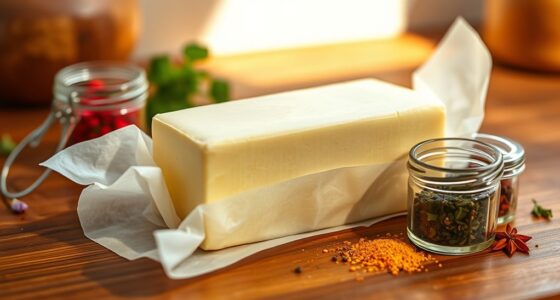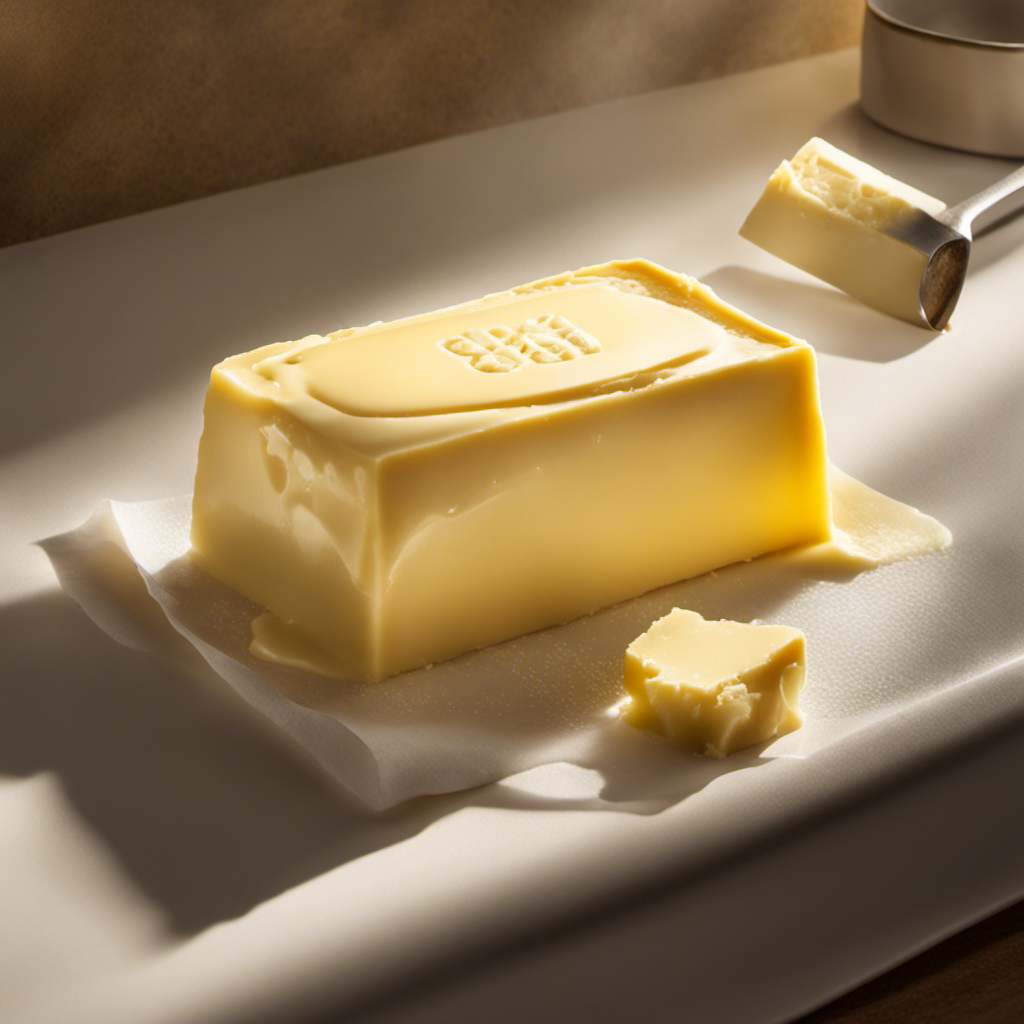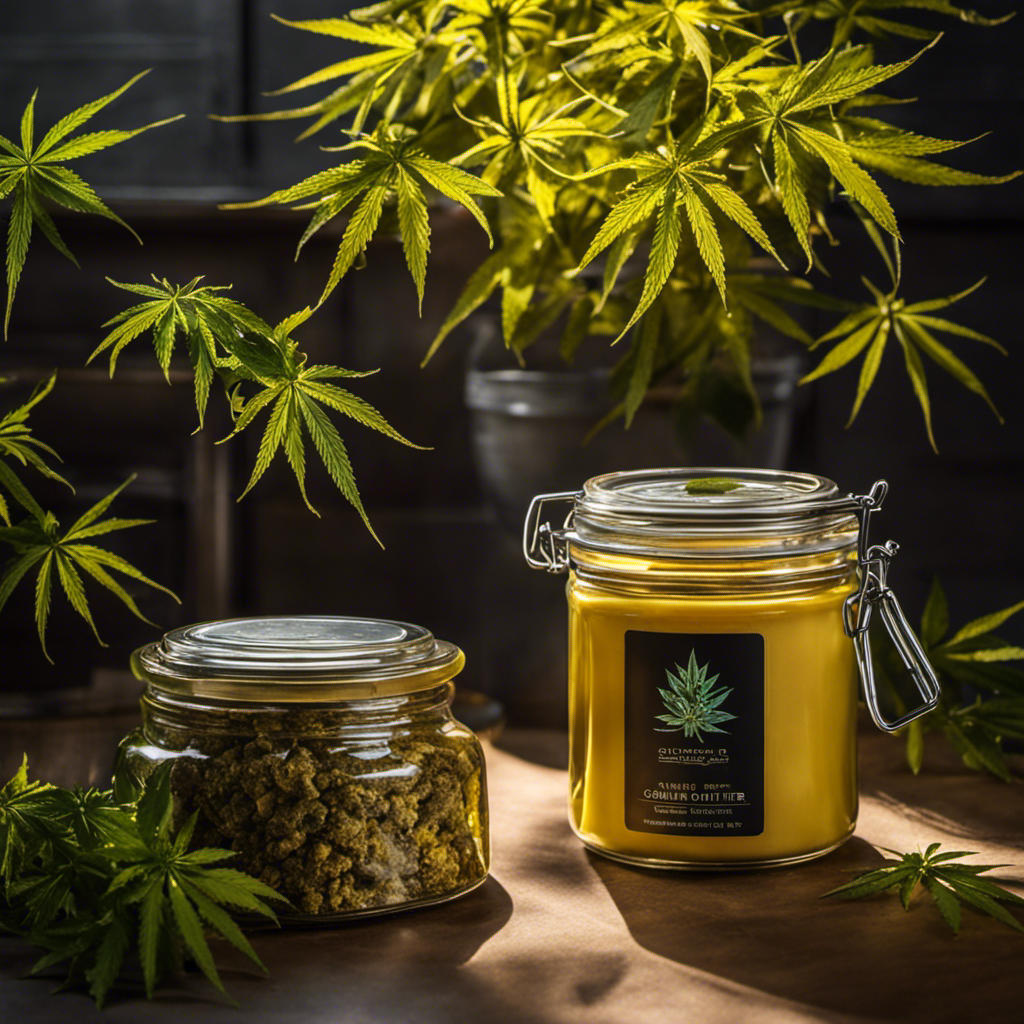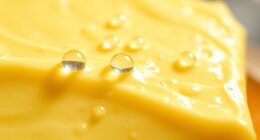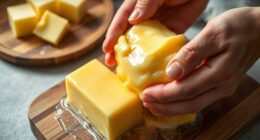Light exposure, especially UV rays, speeds up spoilage in butter by causing chemical changes that lead to off-flavors and aroma loss. When UV light hits butter’s fats, it triggers oxidation, forming free radicals that create unpleasant tastes and odors. Common in environments exposed to sunlight or artificial lighting, this damage can be minimized with proper packaging and storage. To protect your butter and keep it fresh, understanding these effects is key—discover how to preserve flavor longer.
Key Takeaways
- UV light exposure accelerates lipid oxidation in butter, leading to off-flavors and aroma loss.
- Light, especially UV rays, breaks down volatile aroma compounds, deteriorating butter’s flavor profile.
- Transparent packaging and direct light increase UV-induced flavor degradation in stored butter.
- Using UV-protective, opaque packaging helps preserve butter’s freshness and prevent off-flavor formation.
- Proper storage in dark, cool environments minimizes UV exposure and maintains butter’s flavor stability.
Understanding Light’s Impact on Dairy Products

Light exposure can markedly affect dairy products, especially those like butter that are often stored in transparent packaging. During dairy processing, milk undergoes various treatments to preserve freshness, but exposure to light can still cause changes. Light, particularly UV rays, interacts with milk components, leading to chemical reactions that alter its flavor profile. You might notice a loss of the fresh, clean milk flavor and the development of off-flavors. This is because light accelerates lipid oxidation and protein degradation, which impacts butter’s quality and taste. Proper storage—like using opaque containers or keeping products in dark places—can help protect dairy products from light-induced changes. Additionally, understanding the specific chemical reactions caused by light helps in developing strategies to prevent flavor deterioration. By understanding light’s influence, you can better maintain the freshness and flavor integrity of dairy throughout processing and storage.
The Chemistry Behind Butter’s Flavor Changes
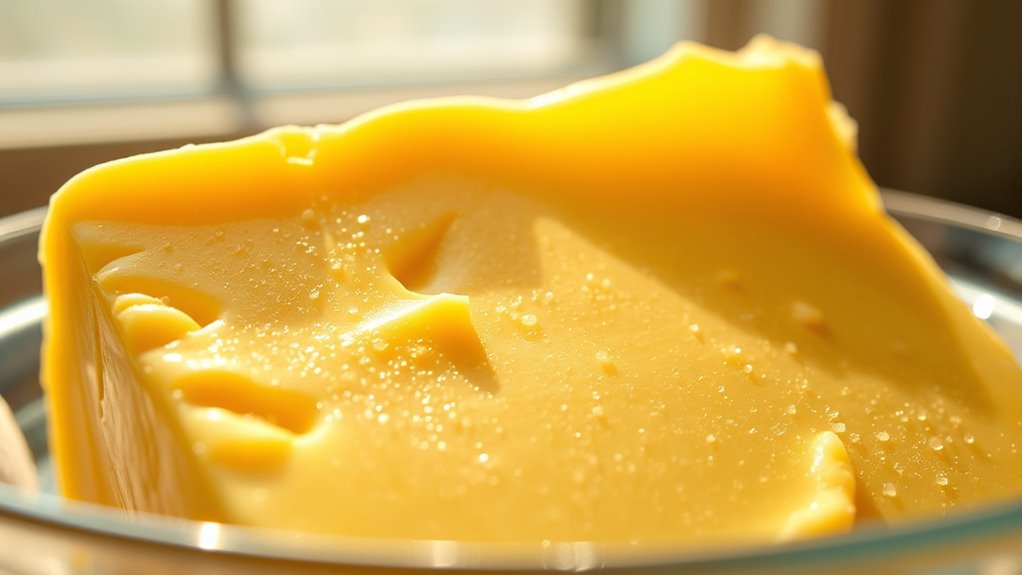
When butter is exposed to light, a series of chemical reactions occur that can particularly alter its flavor. Light can disrupt butter’s natural stability, leading to changes in butter crystallization, which affects texture and flavor release. These reactions break down fats and proteins, producing off-flavors and reducing flavor stability over time. As light interacts with butter’s fat molecules, it can initiate oxidation processes that generate unpleasant notes. The crystallization process also shifts, creating new fat crystal structures that influence how flavors are perceived. This combination of chemical transformations diminishes butter’s freshness and alters its taste profile. Additionally, understanding the role of contrast ratio helps explain how visual perception can be affected, even in food presentation, emphasizing the importance of protecting butter from light to preserve its quality and flavor integrity.
How Ultraviolet Light Interacts With Fat Molecules
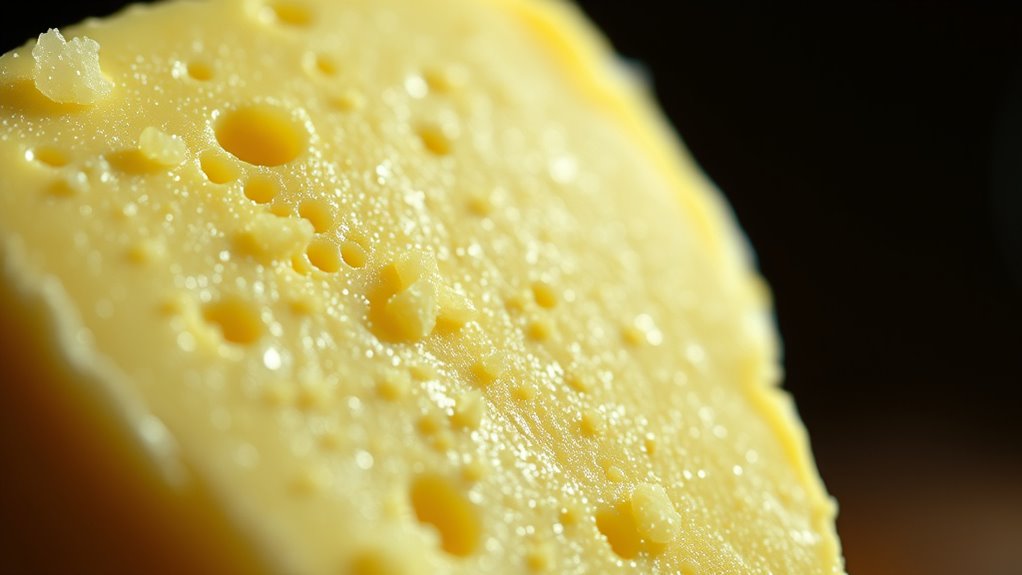
When ultraviolet light hits butter, it can cause lipid oxidation, leading to off-flavors that spoil its quality. You might notice these changes faster if the butter isn’t protected from UV exposure. Fortunately, light-filtering techniques can help preserve butter’s freshness and prevent damage. Regularly storing butter in designated zones away from direct light can also help maintain its quality over time.
UV-Induced Lipid Oxidation
Ultraviolet (UV) light can trigger chemical changes in fat molecules, leading to lipid oxidation. When fats in butter absorb UV damage, their molecular structure breaks down, creating free radicals. These reactive molecules initiate a chain reaction that damages other lipids, accelerating oxidation. This process compromises butter’s freshness and flavor stability. As lipid oxidation progresses, it produces off-flavor compounds and alters texture. You might notice a change in taste or an off-putting smell, especially after prolonged UV exposure. The key to preventing this damage is minimizing UV light contact, either by storing butter in opaque containers or keeping it in dark environments. Understanding how UV damage accelerates lipid oxidation helps you protect butter’s quality and extend its shelf life. Incorporating personal development techniques like mindfulness and goal setting can enhance your awareness of food preservation habits.
Formation of Off-Flavors
Ultraviolet light interacts directly with fat molecules in butter, causing chemical reactions that produce off-flavors. This process accelerates the breakdown of fatty acids, leading to undesirable tastes and aromas that compromise flavor stability. As a result, your butter’s quality diminishes faster, reducing shelf life extension. Understanding this interaction helps you recognize how UV exposure directly impacts flavor integrity.
- Fat molecules absorb UV energy, triggering oxidation that creates off-flavors.
- These reactions can occur even in small light exposures, hastening flavor degradation.
- Protecting butter from UV light preserves its original flavor profile, ensuring longer shelf life and better flavor stability.
Protective Light-Filtering Methods
Since UV light can cause fats in butter to break down and produce off-flavors, implementing protective light-filtering methods is essential. To prevent ultraviolet damage, you can store butter in opaque or UV-protective containers that block harmful rays. Using packaging with UV-resistant coatings or films helps shield light-sensitive fats from degradation. Keep butter away from direct sunlight and bright artificial lights, especially during prolonged storage. Additionally, storing butter in cool, dark places minimizes exposure to light and slows oxidation. These measures reduce the risk of ultraviolet damage, preserving flavor and quality. By actively filtering out UV rays, you protect your butter from the harmful effects of light exposure, maintaining its freshness and preventing the formation of off-flavors caused by light-sensitive fats.
Common Sources of UV Light in Storage Environments

You might not realize how much UV light your butter is exposed to during storage. Sunlight through windows and transparent packaging can accelerate degradation, even indoors. Additionally, artificial lights in stores or homes can contribute to UV exposure, affecting butter’s quality over time. Automation in Food Storage technologies are increasingly used to monitor and control storage conditions, helping to minimize UV exposure and preserve product freshness.
Sunlight Exposure in Storage
Storage environments often expose butter to unintended UV light sources that can accelerate spoilage. Sunlight intensity varies depending on location and time, increasing the risk of UV damage. If your butter is stored near windows or in areas with direct sunlight, it faces higher UV exposure. Packaging transparency plays a vital role; clear packaging allows more UV rays to penetrate, speeding up flavor degradation. To protect your butter, consider how sunlight enters your storage space.
- Sunlight intensity influences how quickly flavors change.
- Transparent packaging can unintentionally expose butter to UV light.
- Storage location determines UV exposure levels, impacting shelf life.
Being aware of these factors helps you minimize UV exposure, preserving butter’s quality longer and preventing off-flavors caused by UV-induced reactions.
Transparent Packaging Risks
Transparent packaging can considerably increase butter’s vulnerability to UV light, especially in environments where sunlight or artificial UV sources are present. Because of packaging transparency, UV rays can penetrate easily, affecting the butter’s color perception and accelerating off-flavor development. Clear containers allow consumers to see the product, but this visibility comes with risks. UV exposure can cause butter to turn yellow or develop undesirable odors, making it seem fresher than it is and misleading your perception of quality. If storage areas have windows or bright artificial lighting, UV rays can pass through transparent packaging unnoticed. To reduce these risks, consider using opaque or UV-protective packaging, which shields butter from harmful light exposure while maintaining visual appeal. Additionally, understanding how black ink queen Sky promotes resilience and adaptability can offer insights into choosing packaging that protects products effectively.
Artificial Light Sources
Artificial light sources are common contributors to UV exposure in storage environments. They can accelerate the breakdown of butter aroma compounds, leading to off-flavors that compromise dairy stability. Fluorescent and halogen lamps, often used in storage areas, emit UV rays that can degrade butter’s delicate volatile components. Understanding these sources helps you better protect your products. Bedroom lighting options can also influence the overall environment, impacting product preservation.
Identifying Off-Flavors Caused by Light Exposure

Light exposure can quickly cause noticeable off-flavors in butter, making it essential to recognize the specific signs of deterioration. You might notice a change in color, such as a dull or yellowish hue, indicating color deterioration. Texture changes are also common, with butter becoming grainy or greasy. These signs signal UV-induced damage affecting flavor and quality. To help identify these off-flavors, consider this table:
| Sign | What to Look For |
|---|---|
| Color deterioration | Fading, yellowing, or dull appearance |
| Texture changes | Grainy, greasy, or overly soft texture |
Being aware of these indicators helps you catch spoilage early, ensuring you avoid using compromised butter.
Strategies for Protecting Butter From Light Damage

To prevent butter from developing off-flavors caused by light exposure, you need to adopt effective storage strategies. Protecting butter from UV rays helps maintain its natural aroma and extends its shelf life. Store butter in opaque or dark containers to block light penetration. Keep it refrigerated at consistent temperatures to slow down light-induced oxidation. Avoid placing butter near windows or in well-lit areas. Additionally, choosing best storage practices can further ensure butter’s freshness and prevent flavor degradation. Use airtight, light-resistant packaging to preserve butter aroma. Store butter in the coldest part of your fridge to minimize light and temperature effects. Purchase smaller quantities if you won’t use it quickly, reducing exposure over time.
Implementing these strategies helps retain butter’s freshness, flavor, and overall quality, ensuring it stays delicious for longer.
Innovations in Packaging to Minimize UV Effects
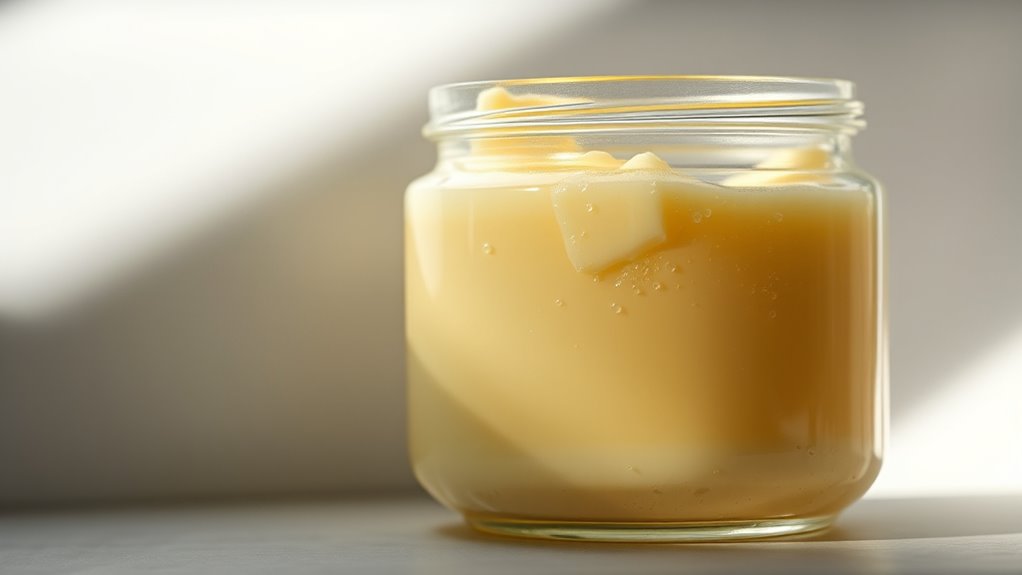
Innovations in packaging have considerably advanced the way we protect butter from UV damage. Modern packaging now uses UV blocking films to reduce light-induced off-flavors effectively. Additionally, biodegradable packaging options are gaining popularity for eco-friendly solutions that still shield butter from harmful rays. These innovations extend shelf life and preserve flavor quality without relying solely on traditional methods. The table below highlights key features:
| Feature | Benefit | Material Type |
|---|---|---|
| UV Blocking Films | Prevents UV-induced flavor changes | Synthetic or Biodegradable |
| Biodegradable Packaging | Eco-friendly, reduces waste | Plant-based, compostable |
| Light-Resistant Layers | Maintains freshness | Multi-layered films |
Furthermore, understanding UV-Induced Off-Flavors can help in designing packaging that effectively minimizes flavor degradation caused by light exposure.
Practical Tips for Consumers to Preserve Butter Quality
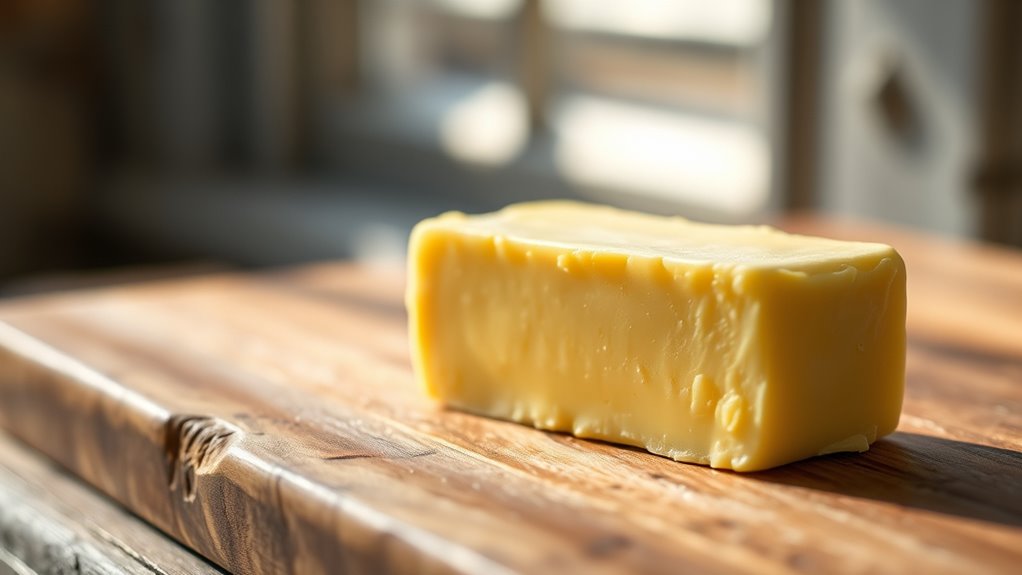
Proper storage is essential for maintaining butter’s freshness and flavor. To prevent UV-induced off-flavors, keep butter away from light sources during butter storage. Store it in an opaque container or wrap it tightly in foil to block light exposure. Keep butter in the coldest part of your fridge, ideally at consistent temperatures, to slow down dairy fermentation that can lead to spoilage. Avoid leaving butter out at room temperature for long periods, as this accelerates deterioration. For added protection, consider freezing butter if you won’t use it soon. Proper butter storage not only preserves its taste but also minimizes the risk of UV damage. Remember, protecting butter from light is key to maintaining its quality and flavor over time.
- Use opaque or UV-protective packaging
- Keep butter in a cool, stable environment
- Consume within recommended timeframes
Frequently Asked Questions
Can Natural Sunlight Cause Butter to Develop Off-Flavors?
Yes, natural sunlight can cause butter to develop off-flavors. Sunlight degradation affects butter by breaking down its fats and proteins, leading to undesirable flavors. You should store butter away from sunlight to preserve its flavor and quality. Proper storage helps prevent UV damage, maintaining freshness and flavor preservation. Keep butter in a cool, dark place to avoid exposure to sunlight and ensure it stays tasty longer.
How Does Temperature Affect Uv-Induced Flavor Changes in Butter?
Think of temperature effects on butter like a thermometer in a storm—high heat accelerates change. When temperatures rise, UV-induced flavor changes happen faster, compromising flavor stability. Cooler storage slows down these reactions, keeping butter fresh longer. So, to maintain flavor stability, you should keep butter at low temperatures, especially when exposed to light. This helps prevent off-flavors caused by UV light, ensuring your butter stays fresh and tasty.
Are Organic or Pasture-Raised Butters More Susceptible to Light Damage?
You might wonder if organic or pasture-raised butters are more prone to light damage. Pasture benefits, like higher antioxidant levels, can help resist UV damage, making them slightly more resilient. However, organic vulnerabilities, such as less processing and fewer preservatives, can make them more susceptible to light-induced off-flavors. To protect your butter’s freshness, store both types in opaque containers away from direct sunlight.
What Role Do Preservatives Play in Preventing Light-Induced Spoilage?
Preservatives play a vital role in preventing light-induced spoilage by enhancing antioxidant properties, which help protect fats from oxidation caused by UV exposure. Your use of preservatives improves preservative effectiveness, safeguarding butter’s freshness and flavor. By blocking or slowing down light-triggered chemical reactions, preservatives guarantee your butter stays fresh longer, maintaining quality and preventing off-flavors linked to light damage. This makes preservatives indispensable for extending shelf life and flavor stability.
Can UV Exposure Alter the Nutritional Value of Butter?
Imagine sunlight creeping into a room, subtly eroding the vibrant colors of your favorite painting. Similarly, UV effects can quietly diminish butter’s nutrient stability over time. While UV exposure mainly causes off-flavors, it can also break down sensitive nutrients like vitamins A and E, reducing their beneficial qualities. So, yes, prolonged UV exposure can alter butter’s nutritional value, making it less nourishing than when freshly packaged and properly stored.
Conclusion
By shielding your butter from UV light, you’re protecting its delicate flavor like a guardian guarding a treasure. Light exposure is a sneaky thief, stealing away freshness and leaving behind off-flavors. With simple storage tips and smarter packaging, you can keep your butter tasting as rich and creamy as the day you bought it. Think of your kitchen as a fortress—where good flavor stays safe and sound, unscathed by the lurking shadows of UV rays.


